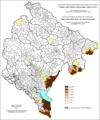Albanians in Montenegro
| Regions with significant populations | ||||||||||||||||
|---|---|---|---|---|---|---|---|---|---|---|---|---|---|---|---|---|
| Ulcinj Municipality | 14,076 | |||||||||||||||
| Podgorica Municipality | 9,538 | |||||||||||||||
| Bar Municipality | 2,515 | |||||||||||||||
| Plav Municipality | 2,475 | |||||||||||||||
| Rožaje Municipality | 1,158 | |||||||||||||||
| Other municipalities | 677 | |||||||||||||||
| Languages | ||||||||||||||||
| Albanian (Gheg dialect), Montenegrin | ||||||||||||||||
| Religion | ||||||||||||||||
| Sunni Islam, Catholicism | ||||||||||||||||
| Related ethnic groups | ||||||||||||||||
| Albanians, Arbëreshë people | ||||||||||||||||
| Part of a series on |
| Albanians |
|---|
 |
|
|
Albanians in Montenegro constitute 4.91% of the county's total population.[2] Albanians of Montenegro are Ghegs[3] who mainly live in South-Eastern Montenegro, in the region commonly known as Malesija as well as in the municipality of Ulcinj (Albanian: Ulqin). The largest city of Albanians in Montenegro is Ulcinj.
Geography
In the municipality of Ulcinj, Albanians form the majority of population (70.66% according to 2011 census). A large Albanian community also exists in the Tuzi area within the Podgorica municipality (making up part of the cultural region known as Malesija). As of 2003, there were a total of 9,296 Albanians in Podgorica municipality, 2,300 of which live in Tuzi (the rest living in the rural area around Tuzi, to the north of Lake Skadar). There is also a significant presence of Albanians in parts of Plav (2,719 or 19.7%)[citation needed] and Rožaje (1,008 or 4.44%), as well as in Bar (3,036 or 7.61%), Hoti, Gruda (Grudë), Zatrijebač (Triesh]]), Koći (Kojë), and Krajina.
Religion
According to the 2003 census, 73.37% of Albanians living in Montenegro were Muslim and 26.08% were Roman Catholic.[4]
Tribes
There are four Malisor Albanian tribes:
Culture

The government of Montenegro provides Albanian-language education in the local primary and secondary schools. There are also some university-level courses in Podgorica offered in Albanian. Montenegrin Albanian culture in this region is closely related to the culture of Albanians in Albania, and the city of Shkodër in particular. Their Albanian language dialect is Gheg as of Albanians in Northern Albania. Predominant religions of Albanians in this region are Roman Catholic and Muslim.
Prominent Individuals
History and Politics
- Mujo Ulqinaku - officer in the Royal Albanian Army and People's Hero of Albania
- Rexhep Qosja - prominent Albanian academic (lives in Kosovo)
- Ded Gjo Luli - (1840–1915) leading nationalists of the Albanian revolt against Turkey.
- Sokol Baci - Albanian leader in the liberation of Malesia from Ottoman rule.
- Baca Kurti Gjokaj - Albanian nationalist
- Alex Rudaj - Albanian-American mobster most famous for leading the Rudaj Organization in the 90s
- Mark Gjonaj - politician Democratic Party for District 80 in the New York State Assembly
Science and Academia
- Gjon Buzuku - Albanian Catholic priest who wrote the first known printed book in the Albanian language: Meshari
- Vinçenc Malaj - Albanian Catholic priest,Albanologist.
- Mirash Lucë Gojçaj - Albanian author, writer.
- Nokë Sinishtaj - Albanian writer and poet
- Anton Gojçaj - Writer and poet,known for his novel "Passio".
- Mark Lucgjonaj - Albanian poet
Music and Entertainment
- Emina Cunmulaj - Albanian-American model
- Afërdita Dreshaj - Albanian-American model
- Hana Cakuli - singer
- Adrian Lulgjuraj - Albanian singer, winner of the Festivali i Këngës 51.
- Nikollë Nikprelaj - Albanian singer
Television and Cinema
- Nickola Shreli - Albanian-American actor
- Victor Gojcaj - Albanian-American actor
- Pjetër Gjoka - actor and People's Artist of Albania
- Pjeter Malota - Albanian actor,martial artist.
- Enver Gjokaj - Albanian-American actor
Sports
- Fatos Bećiraj - footballer
See also
- Malësia
- Malesija, Montenegro
- Greater Albania
- Montenegro
- Albanians
- Albanian Language
- Albanians in Kosovo
- Albanians in the Republic of Macedonia
- Albanians in Central Serbia
Gallery
-
Albanians in Montenegro from 1921 to 2011.
-
Percent of Albanians by municipalities, 1953.
-
Percent of Albanians by settlements, 1961.
-
Percent of Albanians by settlements, 1971.
-
Percent of Albanians by settlements, 1981.
-
Percent of Albanians by settlements, 1991.
-
Percent of Albanians by settlements, 2003.
-
Percent of Albanians by settlements, 2011.
References
- ^ "Popis stanovništva, domaćinstava i stanova u Crnoj Gori 2011. godine" (PDF) (Press release) (in Serbo-Croatian). Statistical office, Montenegro. 12 July 2011. Retrieved 30 March 2011.
{{cite press release}}: Unknown parameter|trans_title=ignored (|trans-title=suggested) (help) - ^ "Census of Population, Households and Dwellings in Montenegro 2011" (PDF). July 12, 2011. Retrieved 13 July 2011.
- ^ Simon Broughton; Mark Ellingham; Richard Trillo (1999). World music: the rough guide. Africa, Europe and the Middle East. Rough Guides. p. 5. ISBN 978-1-85828-635-8. Retrieved 13 July 2013.
Most of the ethnic Albanians that live outside the country are Ghegs, although there is a small Tosk population clustered around the shores of lakes Presp and Ohrid in the south of Macedonia.
- ^ http://www.njegos.org/census/index.htm


















